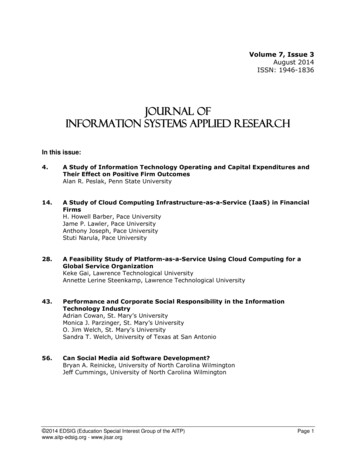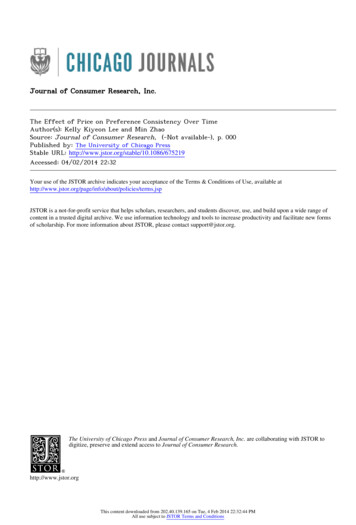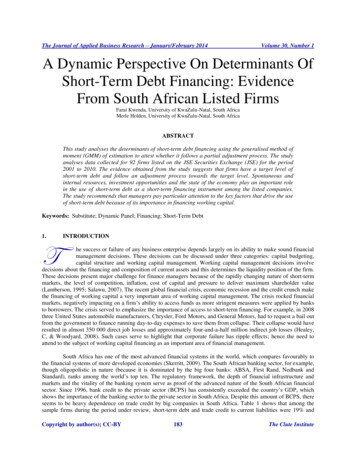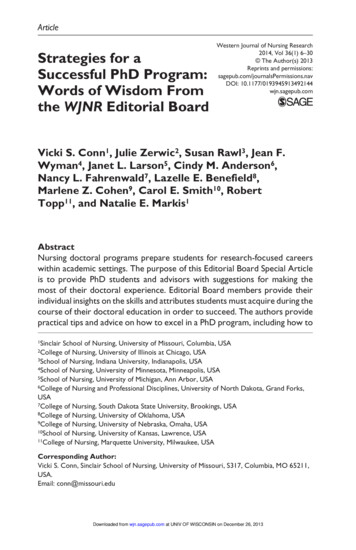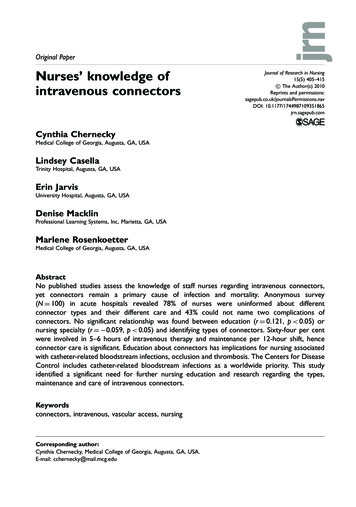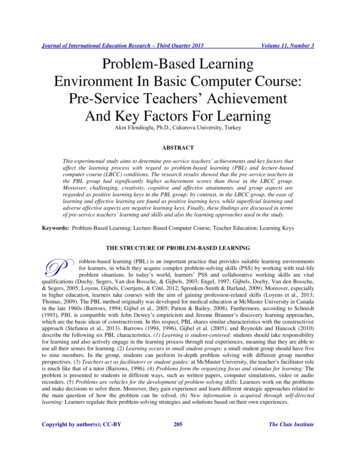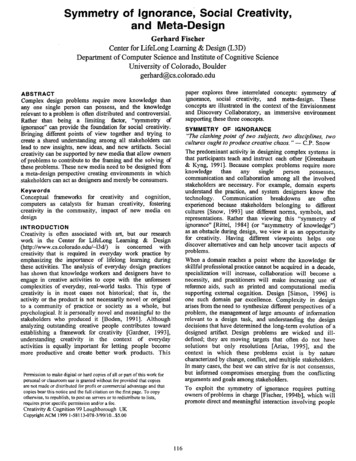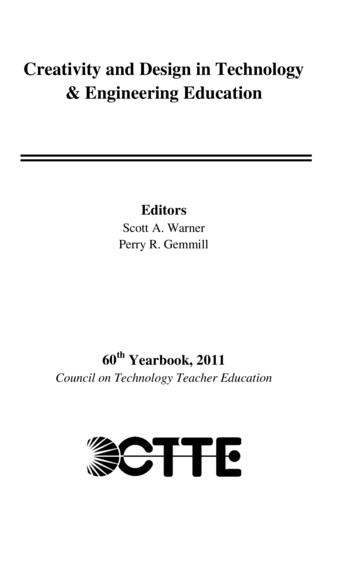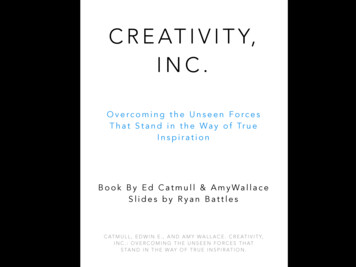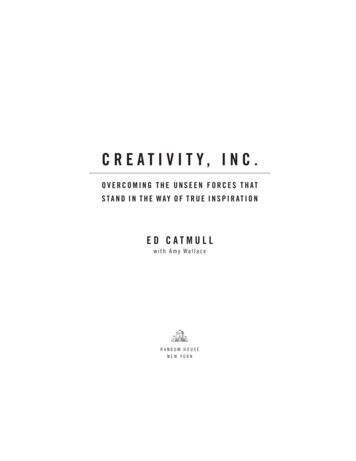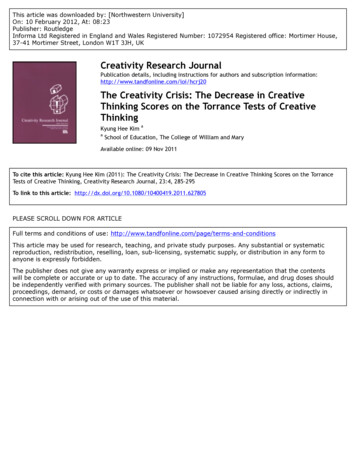
Transcription
This article was downloaded by: [Northwestern University]On: 10 February 2012, At: 08:23Publisher: RoutledgeInforma Ltd Registered in England and Wales Registered Number: 1072954 Registered office: Mortimer House,37-41 Mortimer Street, London W1T 3JH, UKCreativity Research JournalPublication details, including instructions for authors and subscription he Creativity Crisis: The Decrease in CreativeThinking Scores on the Torrance Tests of CreativeThinkingKyung Hee KimaaSchool of Education, The College of William and MaryAvailable online: 09 Nov 2011To cite this article: Kyung Hee Kim (2011): The Creativity Crisis: The Decrease in Creative Thinking Scores on the TorranceTests of Creative Thinking, Creativity Research Journal, 23:4, 285-295To link to this article: SE SCROLL DOWN FOR ARTICLEFull terms and conditions of use: nsThis article may be used for research, teaching, and private study purposes. Any substantial or systematicreproduction, redistribution, reselling, loan, sub-licensing, systematic supply, or distribution in any form toanyone is expressly forbidden.The publisher does not give any warranty express or implied or make any representation that the contentswill be complete or accurate or up to date. The accuracy of any instructions, formulae, and drug doses shouldbe independently verified with primary sources. The publisher shall not be liable for any loss, actions, claims,proceedings, demand, or costs or damages whatsoever or howsoever caused arising directly or indirectly inconnection with or arising out of the use of this material.
CREATIVITY RESEARCH JOURNAL, 23(4), 285–295, 2011Copyright # Taylor & Francis Group, LLCISSN: 1040-0419 print 1532-6934 onlineDOI: 10.1080/10400419.2011.627805The Creativity Crisis: The Decrease in Creative ThinkingScores on the Torrance Tests of Creative ThinkingKyung Hee KimDownloaded by [Northwestern University] at 08:23 10 February 2012School of Education, The College of William and MaryThe Torrance Tests of Creative Thinking (TTCT) was developed in 1966 and renormedfive times: in 1974, 1984, 1990, 1998, and 2008. The total sample for all six normativesamples included 272,599 kindergarten through 12th grade students and adults. Analysis of the normative data showed that creative thinking scores remained static ordecreased, starting at sixth grade. Results also indicated that since 1990, even as IQscores have risen, creative thinking scores have significantly decreased. The decreasefor kindergartners through third graders was the most significant.Research shows that intelligence is increasing (Ceci,1991; Ceci & Williams, 1997; Dickens & Flynn, 2001).Based on the test norms of the Stanford-Binet andWechsler tests, Flynn (1984) concluded IQs haveincreased in the United States over the decades of thelast century, which is now called the Flynn effect. Flynn(2007) later concluded IQs have increased worldwideduring the past century; IQs on the Raven’s Matricesand on the Similarities subtest of the Wechsler Intelligence Scale for Children (WISC) have gained by about25 points; and IQs on the WISC Arithmetic, Information, and Vocabulary subtests have gained by about3 points. Flynn (2007) explained the increase in IQs interms of reduced inbreeding, improved nutrition, orincreased affluence around the world.Contemporaneous with the increase in IQs areincreases in the average scores on the Scholastic Assessment Test (SAT, formerly called the Scholastic AptitudeTest). The SAT is one of the most widely used tests formaking high-stakes decisions about educational opportunities, placements, and diagnoses. The SAT has traditionally been accepted as a specific aptitude measureto assess verbal and mathematical reasoning abilities,but it has a high correlation with IQ (Frey & Detterman,2004). SAT average scores decreased in the 1960s andI thank Scholastic Testing Services, Inc., for providing access to theraw data sets and for their assistance in clarifying their data.Correspondence should be sent to Kyung Hee Kim, School ofEducation, The College of William and Mary, 301 Monticello Avenue,Williamsburg, VA 23187. E-mail: kkim@edu1970s, and then remained stable with slight increasesin the 1980s. Since the 1990s, however, the overall downward trend has been reversed (College Entrance Examination Board, 1993, 2008) and SAT average scoreshave increased, as IQs have increased.CHANGES IN CREATIVE THINKINGWhat of creative thinking? Creativity is distinct fromintelligence. Have average levels of creative thinkingchanged, and if so, have they changed in the same patternas IQ? The TTCT is a good measure to use when examining changes in the potential for creative thinking overtime. That is because it is widely used and psychometrically sound. The TTCT was developed by Torrance in1966. Although the TTCT has been used primarily asan assessment for the identification of gifted children,Torrance (1966) originally intended to use it as a basisfor individualizing instruction for students with anyability level. The TTCT can be administered in eitheran individual or group testing environment from thelevel of kindergarten through adulthood. When predicting creative achievement, Kim (2008a) found scores onthe TTCT predict (r ¼ .33) creative achievement betterthan other measures of creative or divergent thinking.The TTCT is utilized extensively in both the educationalfield and the corporate world, and it is more widely usedand referenced than other measures of creative or divergent thinking. The TTCT has been translated into over35 languages (Millar, 2002) and it is utilized worldwide.
286KIMDownloaded by [Northwestern University] at 08:23 10 February 2012The TTCT has two versions, the TTCT-Verbal and theTTCT-Figural, each with two parallel forms, Form A andForm B. It requires 30 minutes to take each form, so speedis important; however, artistic talent is not required toreceive credit. The TTCT-Figural consists of three activities, with ten minutes allowed to complete each activity. InActivity I, the subject constructs a picture using a pear orjelly bean shape provided on the page as a stimulus. Thestimulus must be an integral part of the picture construction. Activity II requires the subject to use ten incompletefigures to make an object or picture. The last activity,Activity III, is composed of three pages of lines or circleswhich the subject is to use in creating a picture or pictures(Kim, 2006). For the purposes of this article, only theTTCT-Figural will be considered in detail.What the TTCT-Figural MeasuresThe TTCT-Figural has remained unchanged but wasrenormed with each edition of the TTCT manual. The onlysignificant change to the test was revision of scoring procedures in the third edition of the scoring manual in 1984.The current form of the TTCT-Figural includes scoresfor: Fluency, Originality, Elaboration, Abstractness ofTitles (Titles), Resistance to Premature Closure (Closure),and 13 creative personality traits that comprise theCreative Strengths (Strengths) Subscale (see Kim, 2006,for details). The TTCT-Figural has been found to be fairin terms of gender, race, community status, language background, socioeconomic status, and culture (Cramond,1993; Torrance, 1971; Torrance & Torrance, 1972).Torrance (1976; Torrance & Safter, 1986) examinedchanges over time. He reported Fluency, Originality,and Elaboration scores on the TTCT-Figural increasedfrom 1967 (n ¼ 91) to 1976 (n ¼ 108) and from 1976(n ¼ 17,361) to 1982 (n ¼10,957). Torrance (1976)included small samples of only fifth graders from 1967to 1976. Torrance and Safter (1986) included largersamples and represented 31 states from first gradersthrough college students from 1976 to 1982. However,given the small sample sizes for Torrance’s (1976)comparisons in TTCT scores between 1967 and 1976,and the restriction of the sample to only include fifthgraders, the increase in creative thinking scores from1967 to 1976 cannot be generalized.The Scholastic Testing Service, which owns the copyright of the TTCT, reported in the 1998 TTCT manualthat the scores from the 1998 norm-base are comparableoverall to those from the 1990 norm-base. The companyreported in the 2008 TTCT manual that the scores fromthe 2008 norm-base decreased since those from the 1998norm-base. However, these reports are based on the standard scores and the overall composite scores of theTTCT. In addition, the changes in the scoring proceduresfor the TTCT were not considered, and thus comparisonsof the changes among different normative samples of theTTCT are inaccurate. The use of the standard scores isinappropriate because the standard scores have alreadybeen adjusted by the samples’ performance for each ofthe six TTCT norms. Thus, because valid comparisonscannot be made using standard scores, raw subscalescores were analyzed in this study. Additionally,Torrance (1979) discouraged interpretation of scores asa total score or a static measure of a person’s abilityand warned using a composite score may be misleadingbecause each subscale score has independent meaning.Instead, Torrance encouraged the interpretation of subscale scores separately and use of the profile of strengthsand weaknesses as a means to understand and nurture aperson’s creativity.Changes over time may be related to developmentalchanges in creative thinking. Such developmentalchanges were described by Vygotsky (1987, 1990, 1994;see Smolucha, 1992) and Piaget (1950) and are apparentin fairly recent empirical research. Smith and Carlsson(1983), for example, concluded children are not creativein the true sense of creativity before age 10–11 (grades5–6) because they lack the required cognitive sophistication. They argued that children younger than this ageare dependent on accidental impressions and morefocused on material incorporated into their private self;therefore, their attempts for creative activity might bepremature and accidental. Smith and Carlsson (1983)also found high anxiety and creativity in 10–11-year-olds,and then an increase in compulsive and compulsive-likestrategies in 12–13-year-olds (Grades 7–8) accompaniedby a decrease in creativity. Further, Smith and Carlsson(1985) found adolescents’ creativity starts a slow increaseat age 14 (Grade 9), as they develop better anxiety controland learn to be more flexible by age 16. The period ofanxiety and confusion reaches a balance between internaland external by age 16 (Grade 11) so that anxiety is bettercontrolled by flexible adult strategies and self-reliance isrestored (Smith & Carlsson, 1985).Gardner (1982) indicated preschool children havehigh levels of creative ability, and when they enterschool, their artistic creativity tends to decline as theylearn conformity, but begins increasing during preadolescence (Grades 5–8) and continues though adulthood.Some studies indicated a child’s creativity slumpsaround ages 8–9, in fourth grade, the so-called fourthgrade slump. Axtell (1966) detected a decline at thefourth grade in the curiosity of gifted students. Soonafter Torrance (1967) identified a more general slumpin creativity in the fourth grade, and then subsequentlyincreases. Many studies have concluded a large dropin creativity and curiosity occurs when socializationand conformity is initially taught, which in Westernsociety begins in the fourth grade (Axtell, 1966; Kang,1989; Marcon, 1995; Nash, 1974; Timmel, 2001;
Downloaded by [Northwestern University] at 08:23 10 February 2012THE DECREASE IN CREATIVE THINKINGTorrance, 1977; Williams, 1976). Torrance (1977)suggested these decreases occur when children in Western cultures are confronted with new stresses anddemands and are expected to conform to classroom etiquette and peer pressure, and thus their creative abilitiesare discouraged. After the fourth and fifth grades, creativity scores reportedly increase (Torrance, 1967).The fourth-grade slump has also been seen in othercultures, including with Cuban students who emigratedto the United States (Timmel, 2001) and Korean students (Kang, 1989). Georgsdottir and Lubart (2003)found both cognitive flexibility and creativity decreasedamong French students. Torrance (1967) reported theexistence of the fourth-grade slump in seven differentcultures: an advantaged Caucasian student subculturein the United States, a disadvantaged African Americanstudent subculture in the United States, West German,Australian, Norwegian, Indian, and Western Samoan.However, these results show some variation in the timing of the slump because in some cultures a drop in creativity occurs at the end of the third grade or thebeginning of the fourth grade, whereas in some culturesa drop does not occur until the sixth grade. Further, theexistence of a fourth grade slump is disputed becausesome studies have reported contrary findings. Claxton,Pannells, and Rhoads (2005) found a slight increase indivergent-thinking scores between fourth and fifthgrade. Charles and Runco (2001) reported a peak atfourth grade. Sak and Maker (2006) reported no peaksor slumps at the fourth grade.The objective of the present research was to addressthe question of possible changes in creativity thinkingthat have occurred over the last 40 years, using the largeamount of data that is available in the norms of theTTCT. This data set allowed the most extensive analysisyet of changes over time. How has creative thinkingchanged over the last 40 years? Is there a difference inthe changes by different age groups?METHODDataThe data sets for the normative samples for theTTCT-Figural were obtained through the ScholasticTesting Service, Inc. (STS). The TTCT-Verbal is notan interest of this study because it measures mostlydivergent thinking, whereas TTCT-Figural measuresmore than divergent thinking and is used eight to 10times more than TTCT-Verbal.The TTCT was developed in 1966 (n ¼ 3,150) and hasb
I thank Scholastic Testing Services, Inc., for providing access to the raw data sets and for their assistance in clarifying their data. Correspondence should be sent to Kyung Hee Kim, School of Education, The College of William and Mary, 301 Monticello Avenue, Williamsburg, VA 23187. E-mail: kkim@edu CREATIVITY RESEARCH JOURNAL, 23(4), 285 .
